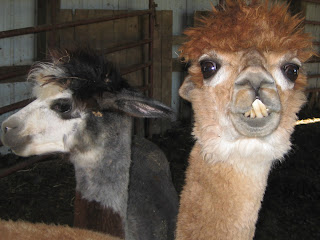 |
| 600 to 800 pound bales of hay |
In November the hay man arrived with his long trailer holding 18 of these beauties. I unloaded them with the front bale spear on my tractor's front end loader and lined up the load along the driveway. A few days later he brought 18 more. I stored those up by the barn.
The hay was bought to feed five cows, seven heifers, a bull, two bull calves, five alpacas and one donkey.
At this writing there are only five bales left - although everyone has at least one bale in their feeders tonight as the temperature drops down to single digits.
 |
| 18 bales stored at the equipment barn yard. |
The bull calves are eating away at their third bale. The alpacas and donkey are working on their second. With just five bales left, the first purchase should last through the end of the February. I had hoped they would last the winter. That's because the cattle stayed on pasture almost through December and by the end of December I'd only put out 12 bales.
But as the cattle enter their last trimester of pregnancy they have begun to eat a lot more! The bull calves have grown over the winter and are also eating much more. Even the alpacas and donkey are munching hay all day now.
 |
L to R: Ginger, Tabitha, Pixel and Hollywick
|
Hay is mostly carbohydrate with enough protein to meet the cattle's needs for a good fodder. Eating carbs keep the cattle and other animals warm. So when the weather get really cold they needs lots of hay to keep their body temperatures up. The cows have thick warm hair covering and can take cold weather as long as they are dry and out of the wind.The alpacas have thick fleece coats that keep them really warm.
At this time of year everyone is bored with nothing else much to do they just keep eating.
 |
Taco Belle, or Belle for short. She keeps the alpacas safe from predators and hollers at me every morning.
|
























